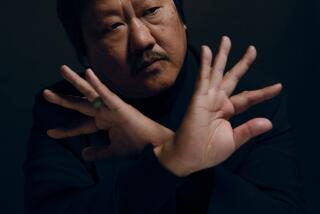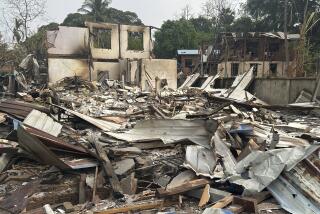Beyond Screen Drama : Filming Revives Horror but Also Gives Hope to Burmese Refugees in O.C.
- Share via
ANAHEIM — Ye Myint still isn’t sure how he survived. In 1988, he and other students were demonstrating peacefully in Rangoon, the capital city of Burma, when troops appeared suddenly and gunned down many of the marchers.
“I was so lucky, because so many people were hit and killed right away,” says Myint, who has been in the United States since 1991 and who now works as a journalist in Anaheim. “I still don’t know how I was so lucky.”
In the spring of 1994--almost six years after the massacre of the students and others--Myint was in Malaysia, reliving those terrifying moments as filmmakers re-created the Burmese army clampdown on pro-democracy movement.
Recruited as an actor for “Beyond Rangoon,” a John Boorman movie that opens countywide today (see accompanying review), Myint cried as he watched the scene unfold. “What they re-created was so real I thought I was there again.”
Another Burmese expatriate who makes his home in Orange County also was on hand for the filming. U Kyaw Win, hired as a special adviser to director Boorman, also felt a rush of emotions during the production: “I was in tears, because these things really happened.”
But what’s important, he says, is what the film can teach Americans who know little of the country that has since been renamed Myanmar but that Win and his compatriots still call Burma. “Beyond Rangoon,” which stars Patricia Arquette 0as an American tourist caught up in the political chaos, is seen by many Burmese expatriates as more than Hollywood entertainment: It’s a rare opportunity for the political spotlight.
The clampdown of ’88 sent hundreds of thousands of refugees streaming out of Burma into Thailand and some 2 million more into the northern jungles from which the Karen and other ethnic minorities have been waging a guerrilla war against the military government for decades. The repression in Myanmar has not eased, says Win, who has ventured back into rebel-held territory on numerous fact-finding missions.
He and his fellow activists hope “Beyond Rangoon” will expose atrocities in Myanmar in the same way that “The Killing Fields” opened the world’s eyes to the tragic situation of Cambodia.
“This movie was heaven-sent. God sent it,” says Win, a longtime activist who works as a counseling professor at Orange Coast College in Costa Mesa. “It’s something I would have liked to do but couldn’t [on my own], and it just came down from heaven. God said, ‘Here’s your chance now, Win; get in and do it. Tell the story about what happened in Burma.’
“I take part in demonstrations, I write articles, I speak whenever I get a chance. My problem is, people here don’t even know where the hell Burma is.”
Myint, who was a rebel soldier for two years after the shootings, also is working for change in Myanmar as editor of the Democracy News Journal, an activist publication based in Anaheim. He has been to several advance screenings of “Beyond Rangoon” and interviewed people afterward; he agrees that the film should go a long way toward educating the public.
Boorman (“Deliverance,” “Excalibur,” “Hope and Glory”) has made it clear that the Burma of 1988 is more than exotic backdrop for his film. He too has said he hopes “Beyond Rangoon” will focus a harsher spotlight on the junta that has ruled the country since a military coup in 1962.
In Myanmar, meanwhile, the regime has been keeping a watchful eye on the project. Partway through the filming, the Malaysian government shut the production down, reportedly under pressure from Myanmar. Permits were reinstated only after Boorman submitted a phony version of the script removing all references to Burma, setting it instead in a fictitious Southeast Asian nation.
Win says Myanmar sent spies to the filming and published an attack on the production (asserting it was backed by the CIA) in a government magazine. Win later published a point-by-point rebuttal in a Burmese-language magazine published in Thailand.
Politics, normally anathema to Hollywood, may help sell this film. Interest in the subject may have been stirred by the recent release of Nobel Prize-winning opposition leader Aung San Suu Kyi, who had been under house arrest in Myanmar since 1989. Ironically, Win says, some observers have speculated that the release of “Beyond Rangoon”--and the publicity it is expected to generate--may have been a factor in Suu Kyi’s release.
“The government is broke. They need money. They need investments,” says Win, a longtime friend of Suu Kyi. “They want tourists to come, and if she were still under house arrest, it would be embarrassing to them.”
Win says his own involvement in “Beyond Rangoon” was “pure luck.” When he got a call from the film’s then-executive producer (who later left), “I really thought it was a prank, you know. I have a buddy in Texas who’s always pulling tricks on me.”
But when Boorman himself showed up at Win’s home in Laguna Niguel, Win signed on. As special adviser, he consulted the director and his crew on matters of historical and cultural accuracy, and even lobbied for changes in the script (in the original, for example, Arquette’s character lost her passport to a pickpocket; Win thought that was a poor reflection on the Burmese and persuaded the writers to leave the loss unexplained).
When, in the Malaysian city of Ipoh, the crew created a full-scale fiberglass model of Rangoon’s towering Sule Pagoda, Win helped ensure its accuracy. When the wardrobe department needed to re-create the look of a Burmese soldier, Win visited rebels on the Thai border and returned with a uniform they had captured. The tiniest of physical details--whether the books in a shop window were right-side up, for instance--fell under his gaze.
He even was recruited to act in two scenes, one as a monk (he shaved his head) and one as an escort to Suu Kyi (played by Adelle Lutz in a pivotal scene). Asked if he enjoyed performing, he answers: “Well, yes, I’m sure, because my great-grandchildren will see me when I’m long gone and say, ‘Oh, that’s my great-grandfather.’ ”
Overall, he says, he found his five months in Malaysia stressful but interesting and gratifying. “I had never been to a movie set. This was the first time. I think the operation is greater than the Normandy invasion.”
Myint, 31, was recruited for his role in the film as a student who comes to the aid of Arquette and her tour guide (played by Aung Ko, another expatriate Burmese activist) when their car breaks down; he reappears later in the movie at the Thai border. At the time he was called--late 1993--he was working on his master’s degree in political science at Illinois State University.
“I was not interested [in the film] because at that time I was focusing on my thesis,” he recalls. But after a casting director came to his school, he was persuaded, and now is glad for it.
“I enjoyed it a lot. It’s a totally different life. I stayed in a five-star hotel for five months. I was flying high. . . . It was very hard for me to adjust back to my small student apartment in Illinois.”
In 1988, after the shootings in Rangoon, Myint had escaped to the jungle terrain of the Thai border where he joined the rebel forces. After repeated bouts with malaria, he went to a refugee camp in Thailand. Because he could speak English well, he became an interpreter for the United Nations and later was given the opportunity to study in the United States.
Since finishing his master’s, he has lived in the Anaheim home of another Burmese activist, Aun Khin, and has worked on the Democracy News Journal (which counts Win among its editorial board members). Myint plans to pursue a doctorate in political science at USC or UCLA, concentrating on transitions to democracy, a specialty he hopes to put to use in his home country someday.
Win, 61, also came to the United States as a student, in 1952. He returned to Burma in 1959, came back to this country in 1961 for a two-year teaching assignment, and ended up staying after the coup of 1962.
He fought a sometimes lonely battle for Burmese democracy through the 1970s and ‘80s, staging protests, making repeated and dangerous forays back into his home country in support of the rebels there, lobbying U.S. lawmakers and, for 20 years until 1992, editing the Burma Bulletin, a newsletter that served as both information clearinghouse and call to arms.
Now, with “Beyond Rangoon,” he feels he is helping to reach more people than ever before. “How many people really read that, you know,” he says, holding a small stack of Burma Bulletins. “The movie will be seen by millions.”
More to Read
Only good movies
Get the Indie Focus newsletter, Mark Olsen's weekly guide to the world of cinema.
You may occasionally receive promotional content from the Los Angeles Times.










